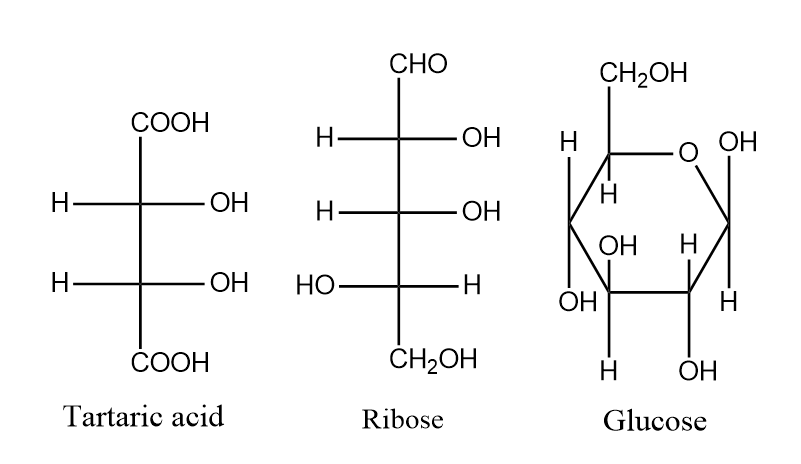Answer
413.4k+ views
Hint: Think about the functional groups common in all the three reactants, tartaric acid, ribose and glucose. Think about the reactions which alcohols and acid anhydrides undergo and write the general reaction and note the ratio of moles of reactants. Compare each of the given compounds in the question to get the answer.
Complete step by step answer:
- The question says, acetic anhydride reacts with tartaric acid, ribose and glucose.
- In all the three molecules only alcohol groups are common. We have studied that alcohols react with acid anhydrides.
- Alcohols react with acid anhydrides or carboxylic acids or acid chlorides to form esters and acid, water and hydrogen chloride respectively. This reaction is called esterification.
- Let’s write a balanced general equation for reaction of alcohol and acetic anhydride.
\[R-OH+A{{c}_{2}}O\to R-OAc+Ac-OH\]
- Therefore, one mole of alcohol reacts with one mole acetic anhydride to form corresponding ester and acetic acid.
- Now, let’s count the number of alcohol (-OH) groups present in each compound.
- Tartaric acid has two –OH groups. So, for two alcohol groups to get completely formed into esters will require two moles of acetic anhydride.
- Ribose has four –OH groups. So, for four alcohol groups to get completely formed into ester will require four moles of acetic anhydride.
- Similarly for glucose, five –OH groups are present so five moles of acetic anhydride is required.
- Therefore, 2, 4 and 5 moles of acetic anhydride $\left( A{{c}_{2}}O \right)$ is needed to react completely with tartaric acid, ribose and glucose respectively.
So, the correct answer is “Option A”.
Note: Remember acid react with acid anhydrides to form esters. This reaction is called esterification. In this reaction, for every alcohol group present in the molecule, one mole of reactant, that is, acetic anhydride or acid chloride, or carboxylic acid is required to get converted into ester.
Complete step by step answer:
- The question says, acetic anhydride reacts with tartaric acid, ribose and glucose.
- In all the three molecules only alcohol groups are common. We have studied that alcohols react with acid anhydrides.
- Alcohols react with acid anhydrides or carboxylic acids or acid chlorides to form esters and acid, water and hydrogen chloride respectively. This reaction is called esterification.
- Let’s write a balanced general equation for reaction of alcohol and acetic anhydride.
\[R-OH+A{{c}_{2}}O\to R-OAc+Ac-OH\]
- Therefore, one mole of alcohol reacts with one mole acetic anhydride to form corresponding ester and acetic acid.
- Now, let’s count the number of alcohol (-OH) groups present in each compound.
- Tartaric acid has two –OH groups. So, for two alcohol groups to get completely formed into esters will require two moles of acetic anhydride.
- Ribose has four –OH groups. So, for four alcohol groups to get completely formed into ester will require four moles of acetic anhydride.
- Similarly for glucose, five –OH groups are present so five moles of acetic anhydride is required.
- Therefore, 2, 4 and 5 moles of acetic anhydride $\left( A{{c}_{2}}O \right)$ is needed to react completely with tartaric acid, ribose and glucose respectively.
So, the correct answer is “Option A”.
Note: Remember acid react with acid anhydrides to form esters. This reaction is called esterification. In this reaction, for every alcohol group present in the molecule, one mole of reactant, that is, acetic anhydride or acid chloride, or carboxylic acid is required to get converted into ester.
Recently Updated Pages
Why Are Noble Gases NonReactive class 11 chemistry CBSE

Let X and Y be the sets of all positive divisors of class 11 maths CBSE

Let x and y be 2 real numbers which satisfy the equations class 11 maths CBSE

Let x 4log 2sqrt 9k 1 + 7 and y dfrac132log 2sqrt5 class 11 maths CBSE

Let x22ax+b20 and x22bx+a20 be two equations Then the class 11 maths CBSE

Let x1x2xn be in an AP of x1 + x4 + x9 + x11 + x20-class-11-maths-CBSE




